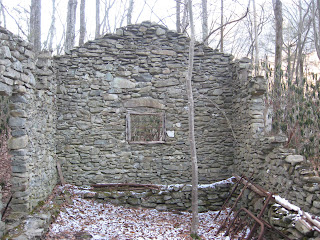



My Saturday hike with the Piedmont Hiking and Outing Club meandered through Morrow Mountain State Park and 3 of the 27 known "prehistoric" quarries in the Uwharries. On Sugarloaf I noted some, mostly larger debris on the descent. We passed by the park headquarters, sporting stone from a more modern, merely "historic" quarry also located within the park. The debris on Hattaway Mountain was of noticeably inferior quality showing lots of white crystals in the dark rhyolite. Finally we marched up the side of Morrow Mountain and into the largest prehistoric quarry in North Carolina.
In the 1930's, just 4 miles away, from a ridge overlooking the Yadkin River, an archaeological site known as the Hardaway Site was discovered. A fellow by the name Coe excavated the area and determined it to be a huge tool making camp. Debris piles demonstrated the advancing tool design over thousands of years. The quality of the rhyolite stone there was unsurpassed in the area. Tools and points found for hundreds of miles were predominately from the Hardaway site. In fact, Hardaway points have been found throughout the eastern US.
In the early 1990's a graduate student, Randy Daniel and one of his mentors, Robert Butler decided to investigate further. They were well aware of Hardaway and the tens of thousands of artifacts found there. The mystery is, where did the stone come from. There was no quarry at Hardaway and no rhyolite. Rhyolite caps many of the Uwharrie mountains but does not occur in abundance elsewhere. Armed with maps, the two set out to find the quarry. The first suspect was Morrow Mountain. However, after several trips they didn't see the huge outcroppings or cliffs they were looking for. Then they realized there were no stones. The Indians had chipped them all apart leaving a debris field several acres large and in places 6 feet deep. In the 1930's the state built a road, parking area and picnic ground on top of the debris.
The rhyolite was the same as the Hardaway tools. You can easily see the quality of this stuff. It has noticeably sharper edges and even sports a serrated edge in many cases. I had previously taken some samples to show around and returned them to the site, on this hike.


















